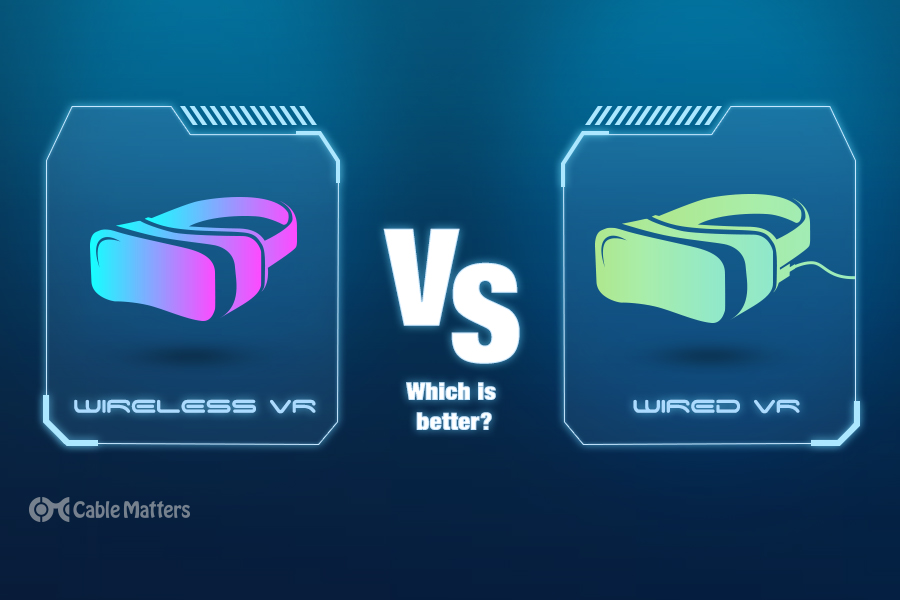
Virtual reality has come leaps and bounds since the first development kit headsets were released in the early 2010s. Low-resolution, bulky devices with restrictive tracking and hefty cables have given way to lighter-weight, higher-resolution options with new features like hand and controller tracking and room-scale spaces. But some headsets offer wireless tracking too, opening up whole new realms of immersion. At least in theory.
With some headsets supporting this new wireless revolution, and others still tethering you to a gaming PC or smartphone, which offers the best VR experience? Wireless VR vs. wired.
What is wireless VR?
Wireless virtual reality is available in a few different guises. The Oculus Quest has a built-in smartphone system on chip (SoC) for onboard processing. It needs no additional hardware and tracks its controllers and physical surroundings with a series of built-in cameras. With it, you can technically walk anywhere you want and remain in virtual reality, as there are no limitations from exterior trackers – the size of your play space is as large as the real space you want to walk around.
The HTC Vive and Vive Pro are compatible with HTC's Vive Wireless adapter, which removes any kind of wired connection to your gaming PC. While you are still limited by the tracking space of your Lighthouse sensors, they can offer between 25m and 100m2, depending on your generation of sensors.
The Oculus Rift S and HTC Vive Cosmos are both still attached to a gaming PC by a cable (the former of which you can extend), but have wirelessly tracked controllers, offering a partial detachment from the real world.
Other wireless solutions include the Oculus Go. The Oculus Go is similar in design to the Oculus Quest, but is limited to just tilt and turn controls. This is called “three degrees of freedom.” Smartphone-based headsets like the Samsung Gear VR have similar limitations and also require a compatible smartphone to act as a screen and a processor.
Is wireless VR worth it?
Wireless virtual reality certainly has its advantages. It detaches you from the real world entirely, meaning you aren't tied to any one place and never need to worry about stepping over, untangling, or even tripping on the cable.
Some wireless VR headsets, like the Oculus Quest and Oculus Go, with their built-in processing, make setup and use incredibly easy. You just have to make sure the headset is charged, then pop it on your face and off you go. The Quest even opens up larger place spaces that would otherwise be possible with a wired headset by eliminating the physical barrier between you and your play space.
Those headsets do have the downside of relying on weaker mobile processors for rendering. The HTC Vive and Vive Pro with wireless adapters solve this issue by tapping into the power of a high-end gaming PC while also providing a wireless experience. But the adapter alone is $300, plus an additional $60 for the Vive Pro adapter, making it a costly upgrade.
Some users have encountered higher CPU loads during wireless transmission, leading to degraded image quality due to compression. Wireless adapters can even overheat during intense or lengthy play sessions.
Wireless virtual reality can be fantastic, but there are some major hurdles. It's impossible to enjoy without making some kind of sacrifice. Whether it’s truly worth it will depend on whether you’re willing to make these sacrifices for additional freedom.
It's an especially hard choice to make when the absolute best VR headsets available right now, happen to be wired.
Why wired VR is still best... for now
It seems almost certain that wireless virtual reality is the long-term future of the medium. It makes it easier than ever for new and experienced VR users to give it a try, and it untethers you from the real world entirely, adding serious immersion.
But for now, if you want the ultimate VR experience, you may be better off with a wired headset. The Pimax 5K and 8K headsets offer the highest resolution and widest field of view of any headset available. Valve's Index headset increases the frame rate to up to 120Hz (144Hz in some cases) and has the best controllers out there right now.
There's a reason it's the top-recommended headset for new VR hit sensation, Half-Life: Alyx.
Those headsets make the rest of the options look entirely pedestrian – if you have a powerful enough PC to run them.
It's not like you can't improve your wired VR gaming experience either. Longer, active HDMI, DisplayPort, and USB 3.0 cables can make it easier than ever to extend your VR gaming rig. In fact, we have a whole guide on it to walk you through exactly what you need. For a TL;DR- if you own one of the many headsets that use DisplayPort, the 7.5m active DisplayPort extension cable is a great option.
The wireless VR gaming revolution is coming, but it's not quite here yet. In the meantime, if you need to extend your cables, be sure to check out Cable Matters.